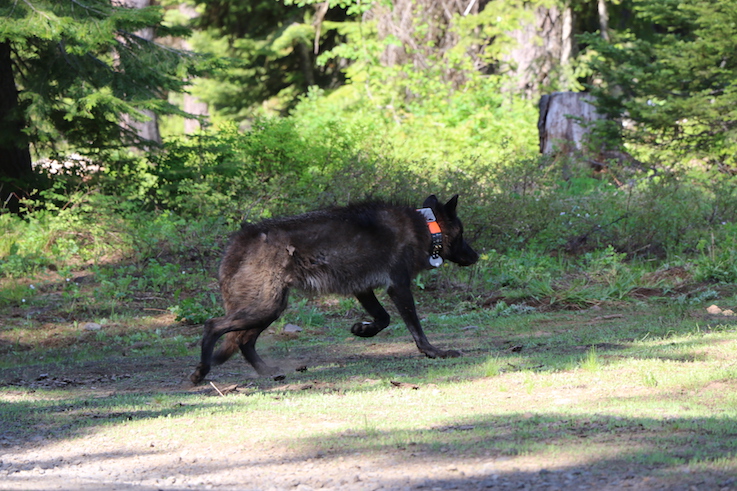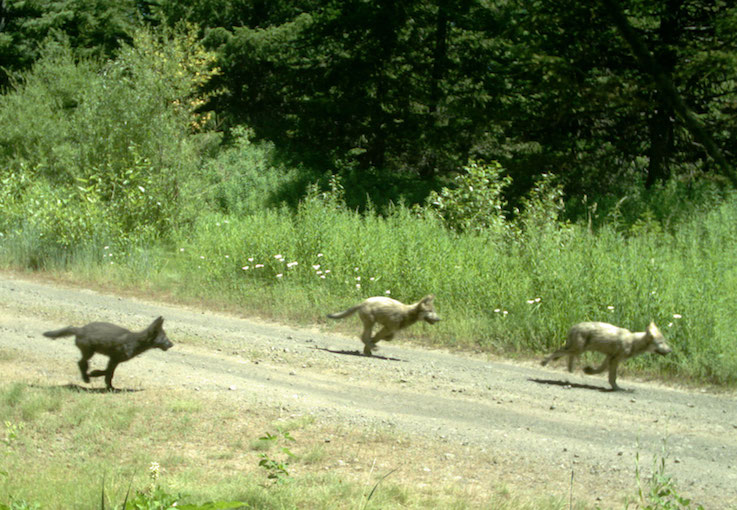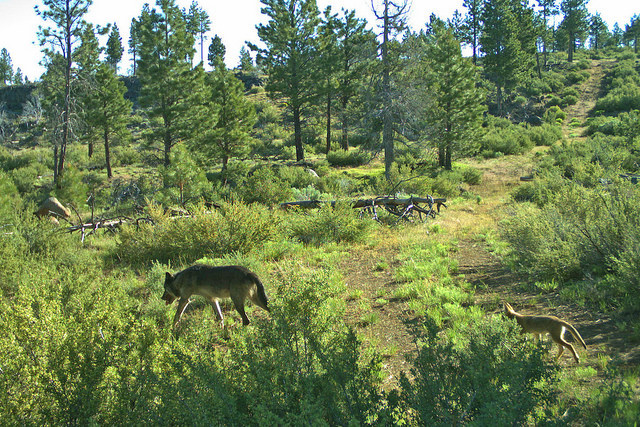
“The Silver Lake Wolves” sounds like the title of a young adult novel, or possibly an indie rock band with lots of close harmony and beards. Actually, it was the name given by the Oregon Department of Fish and Wildlife (ODFW) and the US Fish and Wildlife Service (FWS) to a small family of wolves living near Silver Lake, Oregon, about 75 miles northeast of where I live in Klamath Falls. The family consisted of a male, known as OR 3, a female, known as OR 28, and a single pup. Earlier this month, someone killed OR 28. Because she lived in the western two-thirds of Oregon, she was protected by the Endangered Species Act. Killing her was a federal crime.
I’ve been covering wolves as a journalist for a few years now, and I’m endlessly fascinated by the complex ways we humans see them, relate to them, and interact with them. One clear tension is between seeing each wolf as an individual animal and looking at large numbers of wolves as a population. And the death of a single wolf in a small population tugs hard on that tension.
Conservationists tend to think in population terms. How many wolves does an area need for the population to be viable? What density do we need for them to be ecologically functional? What is the genetic diversity in the population? What are the annual birth and death rates?
But many animal-rights advocates and wolf lovers tend to see these animals as individuals. It is not hard to see why. First of all, they are literally the same species as humanity’s best friend: dogs. Secondly, there are simply far fewer wolves than there are elk or deer or ground squirrels or even other predators like cougar or black bear. At the end of 2015, there were about 110 wolves in the state of Oregon, and more than 71,000 elk, 6,200 cougars and some 25,000 black bears. It is hard to relate to that many bears or cougs, but there are few enough wolves that we can get to know them as individuals.

And we do. Or at least I do. Oregon wolves are my Kardashians. When I get an email alert from the ODFW Gray Wolf Program, I click instantly, eager and nervous to hear what has happened. Has OR7’s pack taken another calf? Who found a mate? How many pups did they have?
So here is some backstory. OR 28 was born into the Mt. Emily pack in Umatilla County. She had a radio collar, so state biologists noticed when she left home at age two, in November of 2015. She made her way to the Silver Lake area, where she met her mate, OR 3. This wolf was quite a bit older. He was born in 2008 in the Imnaha pack, in the Wallowa Mountains in Northeast Oregon and was the brother of OR 7, the first wolf to enter California since the 1920s. He had a collar too, but his wasn’t equipped with GPS, only VHF signals, which requires a nearby receiver to track. So when he left home in May of 2011, he disappeared. State officials had no idea what had become of him until he showed up on the a trail cam in July of 2015 here in Klamath County. Wolves breed in the winter and give birth in the spring, so OR 28 and OR3 consummated their relationship last winter and had their pup in April or thereabouts. It would have stayed in the den with its mother for two weeks, then begun coming out and slowly growing more and more bold. At six months the pup was probably deep into learning to hunt from its parents. Some time in September, one of the wolves likely injured a calf that was grazing on Forest Service land. Then on October 6th, OR 28 was found dead.
FWS is offering $5,000 to catch the person who killed OR 28. The agency is investigating the crime with the help of the Oregon State Police. The wolf’s carcass is being examined at the Service’s National Forensics Laboratory in Ashland, Oregon.
The Humane Society has put another $5,000 on the reward. In their release, Ben Callison, president of the Humane Society Wildlife Land Trust, touched on tension between animals and populations, calling the killing “a crime against an individual animal, her pack, her species and the public.”
The Center for Biological Diversity (CBD) put another $10,000 in the pot. Like a lot of releases they put out when wolves are killed, the email emphasized the tragedy on the level of the individual wolf. “Her family is shattered and her young pup and mate – a male who wandered alone for four years before he found her – are left to fend for themselves,” it reads. It goes on to describe wolves as “intelligent, social animals.” Next to a picture of OR 28 is a large red button that reads “Donate Now.”
This emphasis on the individual has always puzzled me, since the CBD is primarily focused on saving endangered species. They are not an animal rights group. I asked their Executive Director, Kierán Suckling, about their approach, and he says his organization is indeed focused on species rather than individuals and has, in some cases supported the killing of “destructive invasive species threatening endangered species and ecosystem processes.” But individuals is where many people’s hearts are. “There have been lots of psychological studies showing that people connect emotionally to individuals and small groups more than large groups,” Suckling wrote me in an email. “They’ll give hundreds of dollars to help one poor child, tens of dollars to help a family, and very little to help a struggling nation. I’ve seen that dynamic confirmed many times in the Center’s own communications. If you want to mobilize for social change or raise money for social change, you’d be malfeasant to ignore this aspect of human psychology. The trick is to talk the people from where they are at now and bring them to emotionally and intellectually connect with higher levels of being over time.”
The tricky thing about all this for me is that if you zoom all the way out to the species level, to the global picture for Canis lupus, the killing is pretty clearly no big deal. Grey wolves are not endangered or even threatened worldwide. Their range has been reduced by about 1/3 because of human activity and intentional eradication from agricultural areas. But they are taking some of that back, with help and on their own. There are 12,000 wolves in Europe; up to 11,000 in Alaska; 3,600 around the Great Lakes. Canada has a ton. So many that there are controversial culls to protect caribou.
At this level, it makes little sense to worry about the death of a single wolf, when we could be spending our money and tears on species like the Dusky Gopher Frog or the Vancouver Island Marmot—species that have global populations that are seriously tiny and on the verge of complete, global extinction.

But if you zoom all the way down to the individual, the killing is a huge deal—as huge as the killing of any animal is. OR 28 was an animal with memories, a personality, likes and dislikes. We know many animals grieve, and it is not anthropomorphizing to presume that OR 3 and her pup probably mourned her. The fact that wolves and other animals die every day on Earth does not mean that each death is not significant. Neither does the fact that we humans—even the vegans among us—are all causally linked to many animal deaths mean that we aren’t allowed to note their significance. A good hunter takes death seriously too.
John Stephenson, a FWS biologist who works on wolves in Oregon, looks at the killing somewhere in-between the individual and the global species level. His goal is for Oregon to have a thriving population of wolves. For him, the death was a serious crime, but not a major problem at the local population level. “I don’t think it is is going to have much of an impact on wolf recovery in Oregon,” he says. “This won’t be much of a setback.” Although he does add that “it might put the kibosh on a pack forming there for awhile. Not a whole lot of other females in that area.”
Ultimately, I believe that rhetoric like that used by Suckling and the CBD can confuse our emotional reaction to the death of a sentient being with our ecological goals for populations or species. OR 3 and OR 28 may have only had a single pup, but wolves are, in general, fairly robust reproducers and more tolerant of humanized landscapes than we once believed. You can mourn OR 28 as a fellow creature despite the fact that her species is doing pretty well. But to use that grief to fundraise for population-level efforts feels to me like a bait and switch.
Suckling disagrees. He says that in some places, an individual death is a population-level event, and he also thinks that a culture of hating and killing wolves–is part of a broader right-wing cultural movement that threatens the environment at large. “Environmental issues are inextricable from broader cultural concerns,” he says. “They will never be solved if we ignore those concerns and climb into an imaginary environmental shell.”
I wish I could talk to the person who killed OR 28. Did they see OR 28 as a threatening individual? As a member of a hated population? Or perhaps as an abstract political symbol?
More than perhaps any other wild animal, wolves bear the weight of centuries of human cultural baggage, from fairy tale fears of vicious killers to red vs. blue culture wars, to eco-romantic yearnings for true wildness. Sometimes, that weight is fatal.
Hi Emma – First, great to see you’ve joined LWON! I’ve enjoyed your writing on wolves and other topics and look forward to seeing more of it here.
Thanks for this thoughtful reflection on wolves at an individual and species level. I wonder if you’ve considered another lens on the story of wolves – how individual wolves matter at a subspecies/geographic population level for those pops that are struggling to survive or recover from extirpation. While it may be true that taken as a global population gray wolves are not threatened or endangered, we can’t leave out the story of certain subspecies and populations.
Take for example the Mexican wolf population, which is listed as endangered and managed as an experimental population. Here, interestingly, certain individual wolves matter more than others due to the genetic diversity they bring to the population in an already genetically challenged group. If one of those genetically important wolves is killed – as has happened – it impacts the health and potentially survival of the whole subspecies. In that case an individual death is a population event that goes beyond the cultural issues Suckling speaks to. Check out Cally Carswell’s article in High Country News about this (I contributed photos to it): http://www.hcn.org/issues/48.13/line-of-descent-how-poor-management-left-mexican-wolves-dangerously-inbred
Lots of nuances to the story of wolves, thanks for unpacking many of them.
Christina
Christina,
I tried to capture the population-level perspective by talking to John Stephenson, who thinks at the state population level. For this particular individual at this time, he’s not worried about longterm impacts, but as you say, that isn’t always the case. The Mexican wolves are a great example. Suckling also talked to me about Washington’s Profanity Peak Pack, seven members of which have been killed since August. (See http://www.spokesman.com/stories/2016/oct/19/extermination-of-profanity-peak-wolf-pack-halted/) Here, Suckling sees a legit population-level effect. “as the pack constitutes 12% of the statewide population and 14% of the eastern Washington population,” as he wrote.
So, yes, it all depends on what level you are looking at from individual to population to species, and then it also depends on the particulars of the situation.